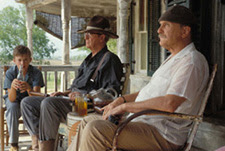I cry at high school football games. More specifically, when the announcer asks everyone to stand, the drums start their buzz roll and a couple of beats later, the rest of band launches into the Star-Spangled Banner. Hand over my heart, feeling my pulse kick up a few beats and, on rare-breeze Friday nights, my eyes focus on the fluttering Stars and Stripes. And then the lip-biting starts ... anything to contain the tears.
Sound like I'm a zealous Yankee Doodle patriot? No, not really.
The tears started September 15, 2001, the first Keller ISD high school football game following the 9/11 attacks on the New York's Twin Towers. I was the Communications Specialist in Keller ISD and that game capped a week of on-the-fly crisis communications.
I don't remember who won the game or even who played, but the chaos and fear on that Tuesday morning, among other things, prompted do-we-play-the-games discussions that must've burned up phone lines among administrators and school board members and probably among school districts across the United States. Do we protect our children? Is it too much to expect students to focus on athletics and arts when they're scared and grieving? Is it safe? Should we have large gatherings in contained areas? Will anybody show up?
Keller ISD had an incredible emergency action and crisis communication plan. It was in place when I started with the district late in 2000. I'm sure the 1999 school shootings at Columbine High School added a few pages to the plan, and I know that the shootings at Fort Worth's Wedgewood Baptist Church later that year (a helluva year) prompted collaborations among school districts to share counseling and communications resources. The church shooting affected a huge number of students, and attracted unprecedented, international media attention that drained Fort Worth ISD's limited resources.
The plan was beautiful. Well-conceived and refined with professional input from counselors and emergency responders. Multi-colored with tabbed pages clearly labeled so that school personnel could easily find and implement an effective and approved response to every imaginable school crisis.
And then the unimaginable happened. Hijacked airliners torpedoed the World Trade Center, and the United States was at war. More importantly, the parents in our community and the kids in our schools were scared.
Driving to work on September 11, I heard on the radio about a plane crashing into the World Trade Center in New York City. I remembered a story my dad had told me about a plane hitting the Empire State Building in the '40s, and my initial thought was "what kind of fool can't avoid a building that big nowadays?"
The rest of the morning is a blur.
An American Airlines jet (Dallas/Fort Worth is the home of American Airlines, and Keller ISD is home to many of its employees) was hijacked and crashed into the World Trade Center. No, two planes have hit both Towers. What? Another plane has crashed in Pennsylvania and another into the Pentagon.
Parents want to pick up their kids. Are we releasing kids? Channel 5 wants to know if schools are closing. The Star-Telegram is asking how we're protecting students. Do we have a statement for the media? Do we allow teachers to turn on their classroom TVs? This is history. What grades can watch the news coverage? What about the kids with parents who work for the airlines? What about employees with family members who work for the airlines? How do we let our campus personnel know what's going on? How do we communicate with parents? Are we having school tomorrow?
Email communications with parents was in its tween years, and the district's website was still in its infancy. Text messaging as mass communications was ... well, never mind. The only guy who knew how to post information on the website wanted to leave and pick up his kids. What do we want to say? Have to say? Who do we say it to, and how do we say it to them?
Fortunately, Keller ISD was blessed with an incredibly talented (and calm), media-savvy Communications Director, a district administration that had full confidence in her judgment, and campus administrators and teachers who were thoroughly trained and could take the existing crisis plan and apply it intelligently, as needed, then wait for further instruction from the superintendent.
So, back to the football game ...
Everybody showed up. I don't remember much about that evening except that the stands were full. Keller ISD's administration, like so many school districts, colleges and pro sports, recognized that the best way to help young people -- okay, just about everybody -- get through this crisis was to keep life as normal as possible. Kids and families needed to be there, needed the comfort of familiarity and the nearness of friends.
I drafted the "message." What was appropriate in a public school setting? Who do we call on for comfort and grief? Who do we offend if we ask for God's loving hand, and who do we offend if we don't? Do I remember? Of course not.
I stood at the top of the bleachers and ticked each step of our pre-game ceremonies off our checklist. It was a breezy night. The flags unfurled. Hand over heart. The drumroll started ... two beats ... the rest of the band joined in.
And then the dam broke. I've cried at every high school football game since.
Follow me on Twitter: @FWgib
Friday, September 6, 2013
Buzz roll ... two beats and (sniffle)
Subscribe to:
Post Comments (Atom)


4 comments:
George, I teared up just reading this piece. Poignant.
My first time to read this & it's beautiful. Thank you George for sharing it again.
It is indeed heart-breaking, beautiful and inspiring. Thank you for posting it.
1st time to read, George. Well done. Took me back.
Post a Comment